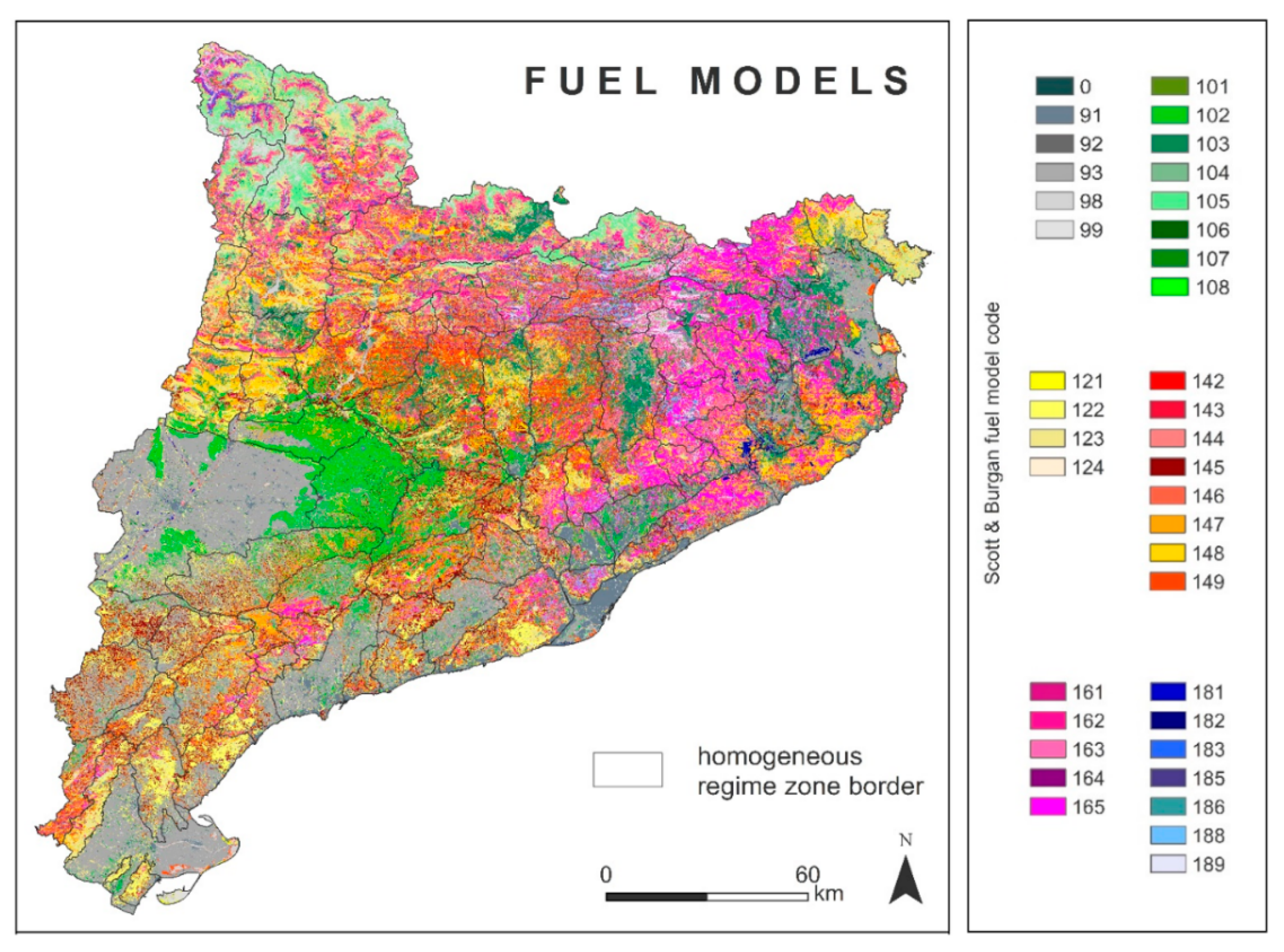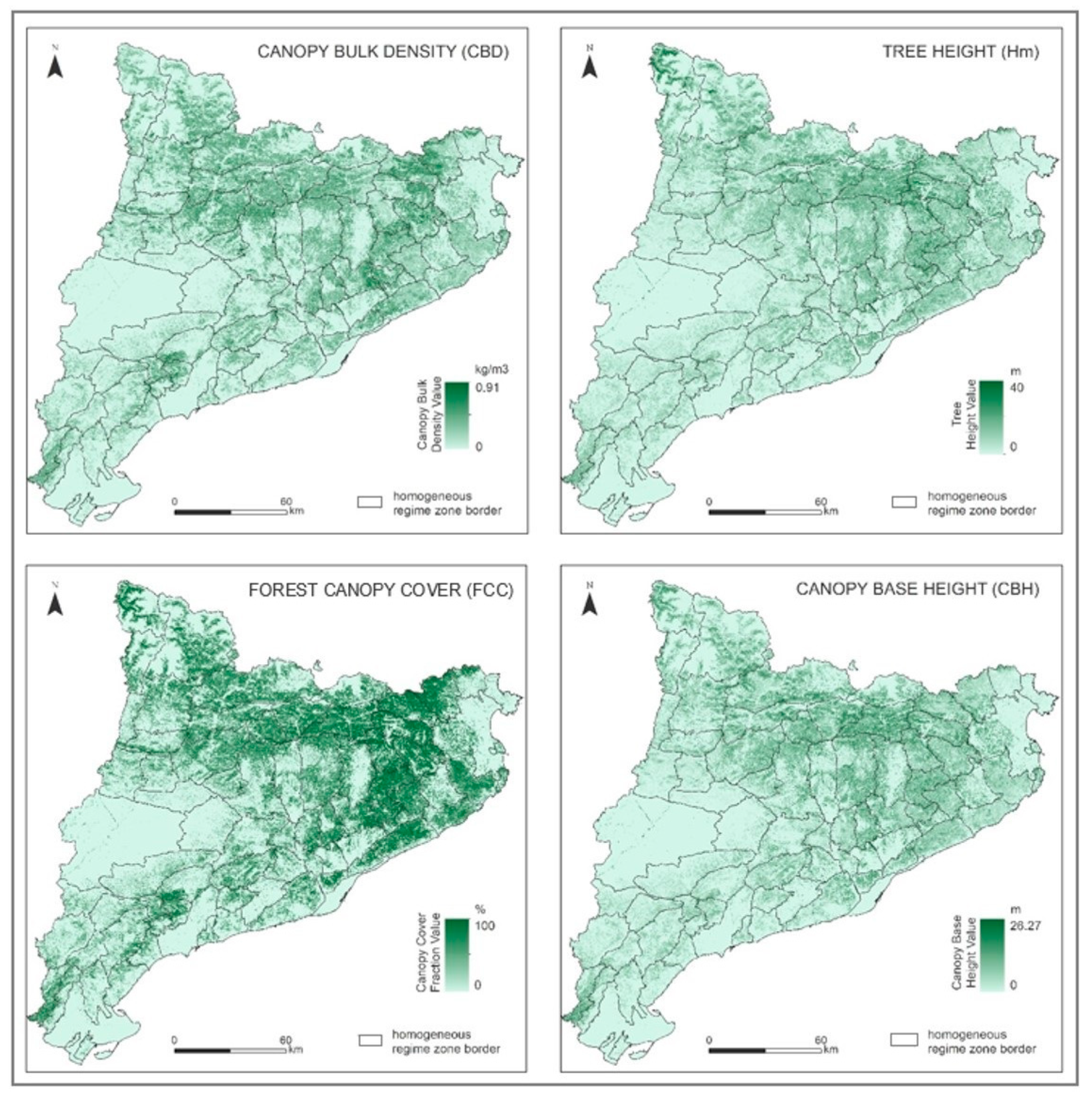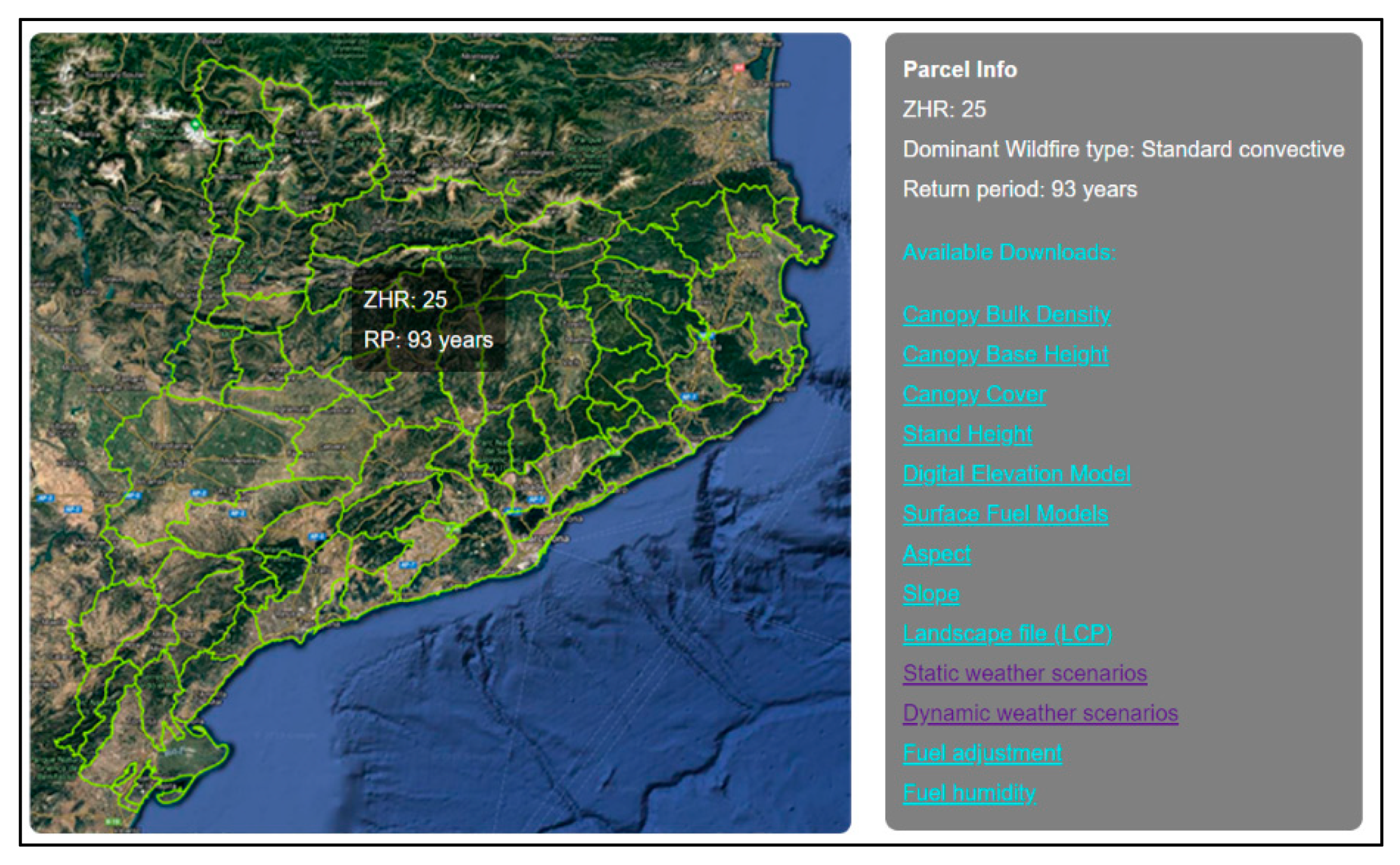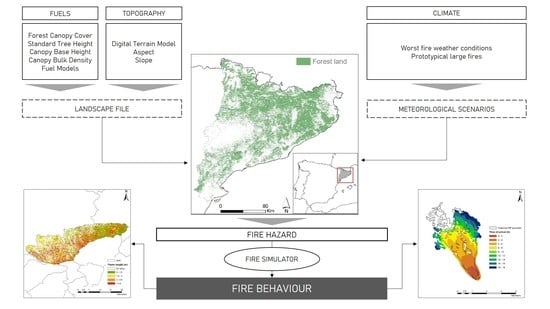Regional Level Data Server for Fire Hazard Evaluation and Fuel Treatments Planning
Abstract
:1. Introduction
2. Materials and Methods
2.1. Study Site and Methodological Approach
2.2. Fire Hazard Evaluation
2.2.1. Fuel Mapping and Landscape File Generation
Calculation of Canopy Base Height Variable
if Hm <= 5 m: Hc = β1 × Hm
Calculation of Canopy Bulk Density Variable
Fuel Models Assignation
2.2.2. Generation of Meteorological Scenarios
3. Results
3.1. Geodatabase and Modelled Maps
3.2. Data Server
4. Data Use and Future Development
5. Conclusions
Supplementary Materials
Author Contributions
Funding
Acknowledgments
Conflicts of Interest
Appendix A
| IFN4 Code | Tree Specie | Mean Canopy Depth (Hc, m) | |
|---|---|---|---|
| 024 | Pinus halepensis | Hm > 5 m → Hc = 1.106 + (0.421 × Hm) | Hm < 5 m → Hc = 0.421 × Hm |
| 021 | Pinus sylvestris | Hm > 5 m → Hc = 1.201 + (0.391 × Hm) | Hm < 5 m → Hc = 0.391 × Hm |
| 045 | Quercus ilex ilex | Hm > 5 m → Hc = −0.328 + (0.640 × Hm) | Hm < 5 m → Hc = 0.640 × Hm |
| 025 | Pinus nigra | Hm > 5 m → Hc = 0.432 + (0.426 × Hm) | Hm < 5 m → Hc = 0.426 × Hm |
| 049 | Quercus ilex ballota | Hm > 5 m → Hc = −0.328 + (0.640 × Hm) | Hm < 5 m → Hc = 0.640 × Hm |
| 022 | Pinus uncinata | Hm > 5 m → Hc = 1.401 + (0.476 × Hm) | Hm < 5 m → Hc = 0.476 × Hm |
| 046 | Quercus suber | Hm > 5 m → Hc = −0.328 + (0.640 × Hm) | Hm < 5 m → Hc = 0.640 × Hm |
| 243 | Quercus humilis | Hm > 5 m → Hc = −0.429 + (0.629 × Hm) | Hm < 5 m → Hc = 0.629 × Hm |
| 050 | Riverbank forests | Hm > 5 m → Hc = 2.121 + (0.375 × Hm) | Hm < 5 m → Hc = 0.375 × Hm |
| 044 | Quercus faginea | Hm > 5 m → Hc = 0.348 + (0.326 × Hm) | Hm < 5 m → Hc = 0.326 × Hm |
| 023 | Pinus pinea | Hm > 5 m → Hc = 0.265 + (0.465 × Hm) | Hm < 5 m → Hc = 0.465 × Hm |
| 071 | Fagus sylvatica | Hm > 5 m → Hc = −0.428 + (0.667 × Hm) | Hm < 5 m → Hc = 0.667 × Hm |
| 042 | Quercus petraea | Hm > 5 m → Hc = −0.688 + (0.624 × Hm) | Hm < 5 m → Hc = 0.624 × Hm |
| 026 | Pinus pinaster | Hm > 5 m → Hc = 1.750 + (0.321 × Hm) | Hm < 5 m → Hc = 0.321 × Hm |
| 031 | Abies alba | Hm > 5 m → Hc = −0.040 + (0.708 × Hm) | Hm < 5 m → Hc = 0.708 × Hm |
| 072 | Castanea Sativa | Hm > 5 m → Hc = −0.131 + (0.592 × Hm) | Hm < 5 m → Hc = 0.592 × Hm |
| 051 | Populus sp. | Hm > 5 m → Hc = −1.609 + (0.769 × Hm) | Hm < 5 m → Hc = 0.769 × Hm |
| 373 | Betula pendula | Hm > 5 m → Hc = −0.455 + (0.653 × Hm) | Hm < 5 m → Hc = 0.653 × Hm |
| 041 | Quercus robur | Hm > 5 m → Hc = −0.688 + (0.624 × Hm) | Hm < 5 m → Hc = 0.624 × Hm |
| 255 | Fraxinus excelsior | Hm > 5 m → Hc = 2.121 + (0.375 × Hm) | Hm < 5 m → Hc = 0.375 × Hm |
| 061 | Eucalyptus sp. | Hm > 5 m → Hc = −0.131 + (0.592 × Hm) | Hm < 5 m → Hc = 0.592 × Hm |
| 079 | Platanus x hybrida | Hm > 5 m → Hc = 1.391 + (0.443 × Hm) | Hm < 5 m → Hc = 0.443 × Hm |
| 028 | Pinus radiata | Hm > 10 m → Hc = 3.279 + (0.444 × Hm) | Hm < 10 m → Hc = 0.444 × Hm |
| 034 | Pseudotsuga menziesii | Hm > 10 m → Hc = 6.247 + (0.250 × Hm) | Hm < 10 m → Hc = 0.250 × Hm |
| 047 | Quercus canariensis | Hm > 5 m → Hc = −1.166 + (0.885 × Hm) | Hm < 5 m → Hc = 0.885 × Hm |
| 043 | Quercus pyrenaica | Hm > 5 m → Hc = −1.166 + (0.885 × Hm) | Hm < 5 m → Hc = 0.885 × Hm |
| 035 | Larix sp. | Hm > 10 m → Hc = 6.247 + (0.250 × Hm) | Hm < 10 m → Hc = 0.250 × Hm |
| 917 | Cedrus sp. | Hm > 10 m → Hc = 6.247 + (0.250 × Hm) | Hm < 10 m → Hc = 0.250 × Hm |
| 033 | Picea sp. | Hm > 10 m → Hc = 6.247 + (0.250 × Hm) | Hm < 10 m → Hc = 0.250 × Hm |
References
- Calkin, D.E.; Thompson, M.P.; Finney, M.A.; Hyde, K.D. A real-time risk-assessment tool supporting wildland fire decision-making. J. For. 2011, 109, 274–280. [Google Scholar] [CrossRef]
- Thompson, M.P.; Calkin, D.E.; Finney, M.A.; Gebert, K.M.; Hand, M.S. A Risk-Based Approach to Wildland Fire Budgetary Planning. For. Sci. 2013, 59, 63–77. [Google Scholar] [CrossRef] [Green Version]
- González-Olabarría, J.R.; Rodríguez, F.; Fernández-Landa, A.; Mola-Yudego, B. Mapping fire risk in the Model Forest of Urbión (Spain) based on airborne LiDAR measurements. For. Ecol. Manag. 2012, 282, 149–156. [Google Scholar] [CrossRef]
- Ramirez, J.; Monedero, S.; Silva, C.A.; Cardil, A. Stochastic decision trigger modelling to assess the probability of wildland fire impact. Sci. Total Environ. 2019, 694, 133505. [Google Scholar] [CrossRef] [PubMed]
- Price, O.F.; Gordon, C.E. The potential for LiDAR technology to map fire fuel hazard over large areas of Australian forest. J. Environ. Manag. 2016, 181, 663–673. [Google Scholar] [CrossRef] [PubMed]
- Riaño, D.; Chuvieco, E.; Ustin, S.L.; Salas, J.; Rodríguez-Pérez, J.R.; Ribeiro, L.M.; Viegas, D.X.; Moreno, J.M.; Fernández, H. Estimation of shrub height for fuel-type mapping combining airborne LiDAR and simultaneous color infrared ortho imaging. Int. J. Wildland Fire 2007, 16, 341–348. [Google Scholar] [CrossRef] [Green Version]
- Arellano-Pérez, S.; Castedo-Dorado, F.; López-Sánchez, C.; González-Ferreiro, E.; Yang, Z.; Díaz-Varela, R.; Álvarez-González, J.; Vega, J.; Ruiz-González, A. Potential of Sentinel-2A Data to Model Surface and Canopy Fuel Characteristics in Relation to Crown Fire Hazard. Remote Sens. 2018, 10, 1645. [Google Scholar] [CrossRef] [Green Version]
- Bottalico, F.; Chirici, G.; Giannini, R.; Mele, S.; Mura, M.; Puxeddu, M.; McRoberts, R.E.; Valbuena, R.; Travaglini, D. Modeling Mediterranean forest structure using airborne laser scanning data. Int. J. Appl. Earth Obs. Geoinf. 2017, 57, 145–153. [Google Scholar] [CrossRef]
- Riaño, D.; Meier, E.; Allgöwer, B.; Chuvieco, E.; Ustin, S.L. Modeling airborne laser scanning data for the spatial generation of critical forest parameters in fire behavior modeling. Remote Sens. Environ. 2003, 86, 177–186. [Google Scholar] [CrossRef]
- Valbuena, R.; Maltamo, M.; Packalen, P. Classification of forest development stages from national low-density lidar datasets: A comparison of machine learning methods. Revista Teledetección 2016, S.I., 15–25. [Google Scholar] [CrossRef] [Green Version]
- Riaño, D.; Chuvieco, E.; Condés, S.; González-Matesanz, J.; Ustin, S.L. Generation of crown bulk density for Pinus sylvestris L. from lidar. Remote Sens. Environ. 2004, 92, 345–352. [Google Scholar] [CrossRef]
- González-Olabarría, J.R.; Pukkala, T. Integrating fire risk considerations in landscape-level forest planning. For. Ecol. Manag. 2011, 261, 278–287. [Google Scholar] [CrossRef]
- De Almeida, D.R.A.; Nelson, B.W.; Schietti, J.; Gorgens, E.B.; Resende, A.F.; Stark, S.C.; Valbuena, R. Contrasting fire damage and fire susceptibility between seasonally flooded forest and upland forest in the Central Amazon using portable profiling LiDAR. Remote Sens. Environ. 2016, 184, 153–160. [Google Scholar] [CrossRef]
- Miller, J.D.; Yool, S.R. Mapping forest post-fire canopy consumption in several overstory types using multi-temporal Landsat TM and ETM data. Remote Sens. Environ. 2002, 82, 481–496. [Google Scholar] [CrossRef]
- Peterson, D.L.; Littell, J.S. Appendix 2: Risk-Based Framework and Risk Case Studies. Risk Assessment for Wildfire in the Western United States. In Effects of Climatic Variability and Change on Forest Ecosystems: A Comprehensive Science Synthesis for the U.S. Forest Sector; Vose, J.M., Peterson, D.L., Patel-Weynand, T., Eds.; General Technical Report PNW-GTR-870; U.S. Department of Agriculture, Forest Service, Pacific Northwest Research Station: Portland, OR, USA, 2012; pp. 249–252. [Google Scholar]
- Calkin, D.E.; Cohen, J.D.; Finney, M.A.; Thompson, M.P. How risk management can prevent future wildfire disasters in the wildland-urban interface. Proc. Natl. Acad. Sci. USA 2014, 111, 746–751. [Google Scholar] [CrossRef] [PubMed] [Green Version]
- Thompson, M.; Lauer, C.; Calkin, D.; Rieck, J.; Stonesifer, C.; Hand, M. Wildfire Response Performance Measurement: Current and Future Directions. Fire 2018, 1, 21. [Google Scholar] [CrossRef] [Green Version]
- Scott, J.H.; Thompson, M.P.; Calkin, D.E. A Wildfire Risk Assessment Framework for Land and Resource Management; General Technical Report RMRS-GTR-315; U.S. Department of Agriculture, Forest Service, Rocky Mountain Research Station: Fort Collins, CO, USA, 2013. [Google Scholar]
- Rodríguez y Silva, F.; Molina Martínez, J.R.; González-Cabán, A. A methodology for determining operational priorities for prevention and suppression of wildland fires. Int. J. Wildland Fire 2014, 23, 544–554. [Google Scholar] [CrossRef]
- Salis, M.; Del Giudice, L.; Arca, B.; Ager, A.A.; Alcasena-Urdiroz, F.; Lozano, O.; Bacciu, V.; Spano, D.; Duce, P. Modeling the effects of different fuel treatment mosaics on wildfire spread and behavior in a Mediterranean agro-pastoral area. J. Environ. Manag. 2018, 212, 490–505. [Google Scholar] [CrossRef]
- Alcasena, F.J.; Salis, M.; Vega-García, C. A fire modeling approach to assess wildfire exposure of valued resources in central Navarra, Spain. Eur. J. For. Res. 2016, 135, 87–107. [Google Scholar] [CrossRef] [Green Version]
- Salis, M.; Ager, A.A.; Arca, B.; Finney, M.A.; Bacciu, V.; Duce, P.; Spano, D. Assessing exposure of human and ecological values to wildfire in Sardinia, Italy. Int. J. Wildland Fire 2013, 22, 549–565. [Google Scholar] [CrossRef]
- Riley, K.; Thompson, M.; Scott, J.; Gilbertson-Day, J. A Model-Based Framework to Evaluate Alternative Wildfire Suppression Strategies. Resources 2018, 7, 4. [Google Scholar] [CrossRef] [Green Version]
- Gonzalez-Olabarria, J.R.; Reynolds, K.M.; Larrañaga, A.; Garcia-Gonzalo, J.; Busquets, E.; Pique, M. Strategic and tactical planning to improve suppression efforts against large forest fires in the Catalonia region of Spain. For. Ecol. Manag. 2019, 432, 612–622. [Google Scholar] [CrossRef]
- Albini, F. Estimating Wildfire Behavior and Effects; General Technical Report INT-30; USDA Forest Service, Intermountain Forest and Range Experiment Station: Ogden, UT, USA, 1976; 92p. [Google Scholar]
- Finney, M. Fire growth using minimum travel time methods. Can. J. For. Res. 2002, 32, 1420–1424. [Google Scholar] [CrossRef]
- Andrews, P. Current status and future needs of the BehavePlus Fire Modeling System. Int. J. Wildland Fire 2014, 23, 21–33. [Google Scholar] [CrossRef] [Green Version]
- Anderson, K.; Englefield, P.; Little, J.; Gerhard Reuter, M. An approach to operational forest fire growth predictions for Canada. Int. J. Wildland Fire 2009, 18, 893–905. [Google Scholar] [CrossRef]
- Pettinari, M.L.; Chuvieco, E. Fire Behavior Simulation from Global Fuel and Climatic Information. Forests 2017, 8, 179. [Google Scholar] [CrossRef] [Green Version]
- Roccaforte, J.P.; Fulé, P.Z.; Covington, W.W. Landscape-scale changes in canopy fuels and potential fire behaviour following ponderosa pine restoration treatments. Int. J. Wildland Fire. 2008, 17, 293–303. [Google Scholar] [CrossRef]
- Finney, M.A.; McHugh, C.W.; Grenfell, I.C.; Riley, K.L.; Short, K.C. A simulation of probabilistic wildfire risk components for the continental United States. Stoch. Environ. Res. Risk Assess. 2011, 25, 973–1000. [Google Scholar] [CrossRef] [Green Version]
- Finney, M.A.; Grenfell, I.C.; McHugh, C.W.; Seli, R.C.; Trethewey, D.; Stratton, R.D.; Brittain, S. A Method for Ensemble Wildland Fire Simulation. Environ. Model. Assess. 2011, 16, 153–167. [Google Scholar] [CrossRef]
- Finney, M.A.; Mchugh, C.W.; Grenfell, I.; Riley, K.L. Continental-scale simulation of burn probabilities, flame lengths, and fire size distribution for the United States. In Proceedings of the VI International Conference on Forest Fire Research, Coiambra, Portugal, 15–18 November 2010; Viegas, D.X., Ed.; Univeristy of Coiambra: Coiambra, Portugal, 2010; pp. 15–18. [Google Scholar]
- Ye, T.; Wang, Y.; Guo, Z.; Li, Y. Factor contribution to fire occurrence, size, & burn probability in a subtropical coniferous forest in East China. PLoS ONE 2017, 12, 1–18. [Google Scholar] [CrossRef] [Green Version]
- Monedero, S.; Ramirez, J.; Molina-Terrén, D.; Cardil, A. Simulating wildfires backwards in time from the final fire perimeter in point-functional fire models. Environ. Model. Softw. 2017, 92, 163–168. [Google Scholar] [CrossRef]
- Ramirez, J.; Monedero, S.; Buckley, D. New approaches in fire simulations analysis with Wildfire Analyst. In Proceedings of the 5th International Wildland Fire Conference, Sun City, South Africa, 9–13 May 2011. [Google Scholar]
- Duane, A.; Aquilué, N.; Gil-Tena, A.; Brotons, L. Integrating fire spread patterns in fire modelling at landscape scale. Environ. Model. Softw. 2016, 86, 219–231. [Google Scholar] [CrossRef]
- Cardil, A.; Merenciano, D.; Molina-Terrén, D. Wildland fire typologies and extreme temperatures in NE Spain. iForest Biogeosci. For. 2016, 10, 9–14. [Google Scholar] [CrossRef] [Green Version]
- Parisien, M.A.; Miller, C.; Parks, S.A.; DeLancey, E.R.; Robinne, F.N.; Flannigan, M.D. The spatially varying influence of humans on fire probability in North America. Environ. Res. Lett. 2016, 11, 075005. [Google Scholar] [CrossRef] [Green Version]
- Garcia, M.; Riaño, D.; Yebra, M.; Salas, F.J.; Cardil, A.; Monedero, S.; Ramirez, J.; Martín, M.P.; Vilar, L.; Gajardo, J.; et al. A Live Fuel Moisture Content product from medium spatial resolution Landsat TM satellite time series ready for implementation in fire behavior models. Remote Sens. 2020, 12, 1714. [Google Scholar] [CrossRef]
- Rollins, M.G. LANDFIRE: A nationally consistent vegetation, wildland fire, and fuel assessment. Int. J. Wildland Fire 2009, 18, 235–249. [Google Scholar] [CrossRef] [Green Version]
- González, J.R.; Pukkala, T. Characterization of forest fires in Catalonia (north-east Spain). Eur. J. For. Res. 2007, 126, 421–429. [Google Scholar] [CrossRef]
- González, J.R.; Palahí, M.; Trasobares, A.; Pukkala, T. A probability model for forest stands in Catalonia (north-east Spain). Ann. For. Sci. 2006, 63, 169–176. [Google Scholar] [CrossRef]
- Díaz-Delgado, R.; Lloret, F.; Pons, X. Spatial patterns of fire occurrence in Catalonia, NE, Spain. Landsc. Ecol. 2004, 19, 731–745. [Google Scholar] [CrossRef] [Green Version]
- Díaz-Delgado, R.; Pons, X. Spatial patterns of forest fires in Catalonia (NE of Spain) along the period 1975–1995: Analysis of vegetation recovery after fire. For. Ecol. Manag. 2001, 147, 67–74. [Google Scholar] [CrossRef]
- Castellnou, M.; Pagés, J.; Larrañaga, A.; Piqué, M. Mapa de Risc D’incendi Tipus de Catalunya (Map of Wildfires in Catalonia Using Fire Types Concept); GRAF-Bombers; Ministry of Home Affairs, Generalitat of Catalonia and Forest Science and Technology Centre of Catalonia: Barcelona, Spain, 2010. [Google Scholar]
- Badia-Perpinyà, A.; Pallares-Barbera, M. Spatial distribution of ignitions in Mediterranean periurban and rural areas: The case of Catalonia. Int. J. Wildland Fire 2006, 15, 187–196. [Google Scholar] [CrossRef]
- Centre de Recerca Ecològica i Aplicacions Forestals. Mapa de Cobertes del Sòl de Catalunya v4 (Land Cover Map of Catalonia v4); CREAF, Ministry of Agriculture, Livestock, Fisheries and Food, Ministry of Home Affairs and Ministry of Territory and Sustainibility, Generalitat of Catalonia: Barcelona, Spain, 2009. [Google Scholar]
- Coll, L.; González-Olabarria, J.R.; Mola-Yudego, B.; Pukkala, T.; Messier, C. Predicting understory maximum shrubs cover using altitude and overstory basal area in different Mediterranean forests. Eur. J. Forest Res. 2011, 130, 55–65. [Google Scholar] [CrossRef] [Green Version]
- MAGRAMA (Ministerio de Agricultura, Pesca y Alimentación). Tercer Inventario Forestal Nacional (The Third National Forest Inventory); Ministry of Agriculture, Fisheries and Food: Madrid, Spain, 2007. [Google Scholar]
- Köppen, W. Das Geographische System der Klimate. Handbuch der Klimatologie; Köppen, W., Geiger, R., Eds.; Verlag von Gebrüder Borntraeger: Berlin, Germany, 1936; Volume 1, Part C; pp. 1–44. [Google Scholar]
- Iberian Climate Atlas. Available online: https://www.aemet.es/es/conocermas/recursos_en_linea/publicaciones_y_estudios/publicaciones/detalles/Atlas-climatologico (accessed on 2 August 2020).
- SPIF (Servei de Prevenció d’Incendis Forestals). Nombre D’incendis i Superficie Cremada per Anys. Període: 1986–2019 (Number of Fires and Burned Area per Years. Period: 1986–2019); Forest Fires Prevention Service, Ministry of Agriculture, Livestock, Fisheries and Food, Generalitat of Catalonia: Barcelona, Spain, 2020. [Google Scholar]
- González Olabarría, J.R.; Pukkala, T.; Palahi, M. Optimising the management of Pinus sylvestris L. stand under risk of fire in Catalonia (north-east of Spain). Ann. For. Sci. 2005, 62, 493–501. [Google Scholar] [CrossRef] [Green Version]
- Finney, M.A. An Overview of FlamMap Fire Modeling Capabilities. In Fuels Management—How to Measure Success: Conference Proceedings, Portland, OR, USA, 28–30 March 2006; Andrews, P.L., Butler, B.W., Eds.; Proceedings RMRS-P-41; U.S. Department of Agriculture, Forest Service, Rocky Mountain Research Station: Fort Collins, CO, USA, 2006; pp. 213–220. [Google Scholar]
- Vericat, P.; Piqué, M.; Koua, O.; Pla, M. Mapa de Formacions Forestals Pures i Mixtes de Catalunya a Partir del Mapa Forestal de España 1:50,000 Digitalitzat (Map of Pure and Mixed Forest Formations of Catalonia Based on the Digitalized Forest Map of Spain 1:50,000); Forest Science and Technology Centre of Catalonia (CTFC): Solsona, Spain, 2010. [Google Scholar]
- ICGC (Institut Cartogràfic i Geològic de Catalunya). Mapa de Variables Biofísiques de L’arbrat de Catalunya (Map of Biophysical Variables of Wooded Forest Areas of Catalonia); Cartographic and Geological Institut of Catalonia, Ministry of Agriculture, Livestock, Fisheries and Food and Ministry of Territory and Sustainibility, Generalitat of Catalonia: Barcelona, Spain, 2016. [Google Scholar]
- MAGRAMA (Ministerio de Agricultura, Pesca y Alimentación). Cuarto Inventario Forestal Nacional (The Fourth National Forest Inventory); Ministry of Agriculture, Fisheries and Food: Madrid, Spain, 2017. [Google Scholar]
- Piqué, M.; Vericat, P.; Cervera, T.; Baiges, T.; Farriol, R. Tipologies Forestals Arbrades. In Orientacions de Gestió Forestal Sostenible per a Catalunya (ORGEST) (Typologies of Wooded Forest Areas. Orientacions of Sustainable Forest Management in Catalonia); Ministry of Agriculture, Livestock, Fisheries and Food, Generalitat of Catalonia: Barcelona, Spain, 2011. [Google Scholar]
- ICGC (Institut Cartogràfic i Geològic de Catalunya). Cartographic and Geological Institute of Catalonia, Ministry of Agriculture, Livestock, Fisheries and Food and Ministry of Territory and Sustainability, Generalitat of Catalonia. Available online: https://www.icgc.cat/Descarregues/Elevacions (accessed on 13 October 2020).
- Scott, J.H.; Reinhardt, E.D. Assessing Crown Fire Potential by Linking Models of Surface and Crown Fire Behavior; USDA Forest Service: Fort Collins, CO, USA, 2001. [Google Scholar]
- Scott, J.H.; Burgan, R.E. Standard Fire Behavior Fuel Models: A Comprehensive Set for Use with Rothermel’s Surface Fire Spread Model; USDA Forest Service, Rocky Mountain Research Station: Fort Collins, CO, USA, 2005. [Google Scholar]
- Rothermel, R.C. A Mathematical Model for Predicting Fire Spread in Wildland Fuels; Research Paper INT-115; U.S. Department of Agriculture, Intermountain Forest and Range Experiment Station: Ogden, UT, USA, 1972; 40p. [Google Scholar]
- Anderson, H.E. Aids to Determining Fuel Models for Estimating Fire Behavior; General Technical Report INT-122; U.S. Department of Agriculture, Forest Service, Intermountain Forest and Range Experiment Station: Ogden, UT, USA, 1982; 22p. [Google Scholar]
- Ninyerola, M.; Pons, X.; Roure, J.M. Atlas Climático Digital de la Península Ibérica. Metodología y Aplicaciones en Bioclimatología y Geobotánica; Universidad Autónoma de Barcelona: Cerdanyola del Vallès, Spain, 2005. [Google Scholar]
- Servei Meteorològic de Catalunya (Meteorological Service of Catalonia). Available online: https://www.meteo.cat/observacions/xema (accessed on 24 March 2018).
- Duane, A.; Piqué, M.; Castellnou, M.; Brotons, L. Predictive modelling of fire occurrences from different fire spread patterns in Mediterranean landscapes. Int. J. Wildland Fire 2005, 24, 407–418. [Google Scholar] [CrossRef]
- Cardil, A.; Monedero, S.; Silva, C.A.; Ramirez, J. Adjusting the rate of spread of fire simulations in real-time. Ecol. Model. 2019, 395, 39–44. [Google Scholar] [CrossRef]
- PREVINCAT. Available online: http://previncat.ctfc.cat/ (accessed on 13 October 2020).
- Finney, M.A. FARSITE: Fire Area Simulator-Model Development and Evaluation; Research Paper RMRS-RP-4, Revised 2004; U.S. Department of Agriculture, Forest Service, Rocky Mountain Research Station: Ogden, UT, USA, 1998; 47p. [Google Scholar]
- WildfireAnalyst. Available online: https://tecnosylva.es/wildfire-analyst (accessed on 13 October 2020).









| Variable | Unit | Data Processing |
|---|---|---|
| Forest canopy cover (FCC) | % | Original data, not processed |
| Standard height (SH) | meters | Original data, not processed |
| Canopy base height (CBH) | meters | Parameterized and (geospatially) modelled |
| Canopy bulk density (CBD) | kg/m3 | Parameterized and (geospatially) modelled |
| Fuel models (FM) | Categories | Parameterized and (geospatially) modelled |
| Digital Terrain Model (DTM) | meters | Original data, not processed |
| Slope (SL) | % | Geospatially transformed |
| Aspect (ASP) | degrees | Geospatially transformed |
| Vegetation Types | Fuel Type by Scott and Burgan [63] |
|---|---|
| Wooded forest area | Slash-Blowdown (SB), Timber Litter (TL), Timber Litter (TL) |
| Regenerated forest | Shrub (SH) |
| Scrubland | Grass-Shrub (GS), Shrub (SH) |
| Grassland | Grass (GR) |
| Non-burnable | Non-burnable (NB) |
Publisher’s Note: MDPI stays neutral with regard to jurisdictional claims in published maps and institutional affiliations. |
© 2020 by the authors. Licensee MDPI, Basel, Switzerland. This article is an open access article distributed under the terms and conditions of the Creative Commons Attribution (CC BY) license (http://creativecommons.org/licenses/by/4.0/).
Share and Cite
Krsnik, G.; Busquets Olivé, E.; Piqué Nicolau, M.; Larrañaga, A.; Cardil, A.; García-Gonzalo, J.; González Olabarría, J.R. Regional Level Data Server for Fire Hazard Evaluation and Fuel Treatments Planning. Remote Sens. 2020, 12, 4124. https://doi.org/10.3390/rs12244124
Krsnik G, Busquets Olivé E, Piqué Nicolau M, Larrañaga A, Cardil A, García-Gonzalo J, González Olabarría JR. Regional Level Data Server for Fire Hazard Evaluation and Fuel Treatments Planning. Remote Sensing. 2020; 12(24):4124. https://doi.org/10.3390/rs12244124
Chicago/Turabian StyleKrsnik, Goran, Eduard Busquets Olivé, Míriam Piqué Nicolau, Asier Larrañaga, Adrián Cardil, Jordi García-Gonzalo, and José Ramón González Olabarría. 2020. "Regional Level Data Server for Fire Hazard Evaluation and Fuel Treatments Planning" Remote Sensing 12, no. 24: 4124. https://doi.org/10.3390/rs12244124









